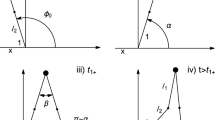Abstract
The paper continues studies intended to find out whether it is possible to create a prototype walking machine with relatively simple components. In this connection, the control problem is solved for a two-dimensional model of biped machine. It has a torso and two telescopic legs. Each leg includes a ponderable section of constant length and an imponderable section of variable length. The machine, regarded as a system with variable constraints, implements a single-stance gait (one stance leg at a time) with a step of constant duration. The contact of the swing leg with the ground is analyzed within the framework of Carnot's theorem (perfectly inelastic impact). It is assumed that the force developed in the stance leg is due to the deformation of the leg's spring and that this deformation can be controlled. An algorithm is proposed to synthesize a control system that takes into account collisions occurring at reverse of the roles of the legs. This algorithm is based on methods of optimizing periodic systems. The algorithm is compared with approaches used by other authors
Similar content being viewed by others
REFERENCES
P. P. Appell, Traite de Mecanique Rationnelle, Gauthier-Villars, Paris (1953).
B. A. Bordyug, V. B. Larin, and A. G. Timoshenko, Control Problems for Walking Machines [in Russian], Naukova Dumka, Kiev (1985).
V. B. Larin, “Optimization of periodic systems with a degenerate weight matrix defining the quadratic form of control actions,” Probl. Upravl. Inform., No. 2, 33-46 (1998).
V. B. Larin and V. M. Matiyasevich, “A note on a model hopping machine,” Int. Appl. Mech., 38, No. 10, 1272-1279 (2002).
V. B. Larin and V. M. Matiyasevich, “Control of a hopping machine,” Probl. Upravl. Inform., No. 4, 5-20 (2002).
E. P. Popov, A. F. Vereshchagin, and S. L. Zenkevich, Robot Manipulators: Dynamics and Algorithms [in Russian], Nauka, Moscow (1978).
D. M. Himmelblau, Applied Nonlinear Programming, McGraw Hill, New York (1972).
F. A. Aliev and V. B. Larin, Optimization of Linear Control Systems: Analytical Methods and Computational Algorithms, Gordon and Breach Sci. Publ., Amsterdam (1998).
R. Brockett, “Hybrid models for motion control systems,” in: H. Trentelman and J. C. Willems (eds.), Perspectives in Control, Birkhauser, Cambridge (1993), pp. 29-54.
B. Goodwine and J. W. Burdick, “Controllability of kinematic control systems on stratified configuration spaces,” IEEE Trans. Automat. Contr., 46, No. 3, 358-368 (2001).
J. W. Grizzle, G. Abba, and F. Plestan, “Asymptotically stable walking for biped robots: analysis via systems with impulse effects,” IEEE Trans. Automat. Contr., 46, No. 1, 51-64 (2001).
Y. Hurmuzlu, “Dynamics of bipedal gait. Part 1. Objective functions and the contact even of a planar five-link biped,” J. Appl. Mech., 60, 331-336 (1993).
Y. Hurmuzlu, “Dynamics of bipedal gait. Part 2. Stability analysis of a planar five-link biped,” J. Appl. Mech., 60, 337-343 (1993).
V. B. Larin, “Optimization of periodic systems,” Sov. Fiz. Dokl., 23, 172-175 (1978).
V. B. Larin, “Method of periodic optimization in stabilization problems of biped apparatus,” in: K. Iracki, K. Malinowski, and S. Walukiewicz (eds.), Optimization Techniques, Part 2, Lecture Notes in Control and Information Sciences, 23, Springer, Berlin (1980), pp. 593-599.
V. B. Larin, “Optimization of periodic systems,” J. Appl. Math. Mech., 44, No. 8, 727-732 (1980).
V. B. Larin, “Control of a walking apparatus,” Soviet J. Comp. Syst. Sci., 27, No. 1, 1-7 (1989).
V. B. Larin, “Problems of control of machines that walk,” Int. Appl. Mech., 29, No. 10, 868-872 (1993).
V. B. Larin, “Problem of control of a hopping apparatus,” J. Franklin Inst., 335B, No. 3, 579-595 (1998).
V. B. Larin, “Control of statically unstable legged vehicles,” Int. Appl. Mech., 36, No. 6, 729-758 (2000).
V. B. Larin, “Attitude-determination problems for a rigid body,” Int. Appl. Mech., 37, No. 7, 870-898 (2001).
V. B. Larin, “Using linear matrix inequalities in synthesis of a stabilizing system for a hopping apparatus,” Int. Appl. Mech., 37, No. 10, 1352-1358 (2001).
V. B. Larin, “Control problems for systems with uncertainty,” Int. Appl. Mech., 37, No. 12, 1539-1567 (2001).
M. W. Spong, “Passivity based control of the compass gait biped,” in: Proc. IF AC 14th Triennial World Congress, Robot Control: High Quality, Paper No B-1d-01-4 (1999), pp. 19-24.
Author information
Authors and Affiliations
Rights and permissions
About this article
Cite this article
Larin, V.B. A Note on a Walking Machine Model. International Applied Mechanics 39, 484–492 (2003). https://doi.org/10.1023/A:1024991521309
Issue Date:
DOI: https://doi.org/10.1023/A:1024991521309




